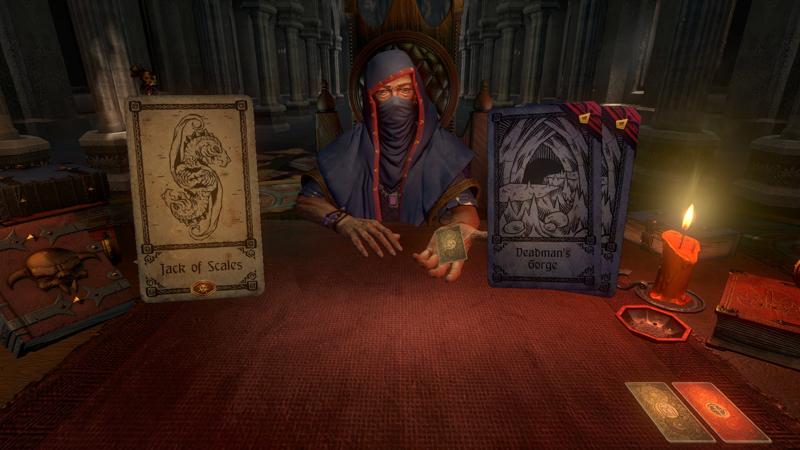Clever Gameplay ‘Hand of Fate’s’ Focal Point
A character from Hand of Fate deals to the player. The video game, a trading card simulator with third- person combat elements, suffers from graphical issues and an overemphasis on luck.
December 11, 2015
There are two cards in front of my small golden game piece, each one representing an upcoming encounter. I don’t have enough food to sustain my character, and my health points are down to 20. This all means I’ll be dead soon unless I get some supplies, even if these encounters don’t end up being especially dangerous. I take a breath and press the ‘A’ button; the card flips over, and I die in 30 seconds. Moments like these, which seem arbitrary and completely luck-based, happen each and every game. It’s learning how to deal with such situations that lends Hand of Fate its charm and makes it such an engrossing game to play.
A game from Defiant Development that received a proper release in the first half of 2015, Hand of Fate is difficult to pin down. At its base it’s a deck-building card game simulator. However, instead of playing against an enemy in card battles, you actually battle the cards. Some cards are combative — switching the game to third-person combat, complete with counters and combos — while others are stories or scenes with branching paths. This variation is what makes this game so fascinating.
The central concept itself is beyond satisfying. Nearly everything about the game is up to the player, such as what equipment is accessible over their progression through the deck and the majority of the encounters they’ll come across. On top of this, most cards that you get — when encountered and completed successfully for the first time — unlock more cards.
Although these core concepts are unique and well thought out, the sub-systems in Hand of Fate demonstrate its lack of polish. Firstly, the graphics are nothing incredible. They look cartoony in a vein similar to many other games in this genre, doing little to differentiate themselves. The combat itself is also very simplistic: You essentially just hit, counter and cast magic. There are a couple of mix-ups in fights, such as ranged attacks and hits which cannot be countered, but that’s as deep as it goes. Sure, it gets tough, but difficulty does not equate greatness. Also, encounters seem to become more and more reliant on luck as the game goes on.
One last thing to consider is the fact that if you use a controller plugged into your computer, it won’t work all the time. For me, it cut out control for at least five seconds every minute, which wouldn’t be that frustrating if combat didn’t require good timing throughout. I had to lower the difficulty before finishing the first round of bosses because I couldn’t win with constant controller malfunctions.
Despite all of these complaints, I still find myself enjoying Hand of Fate. I love the card game aesthetic, even if the graphics can’t keep up. Although the game has its downsides, I still can’t help but return to this whimsical game of luck and strategy.





















